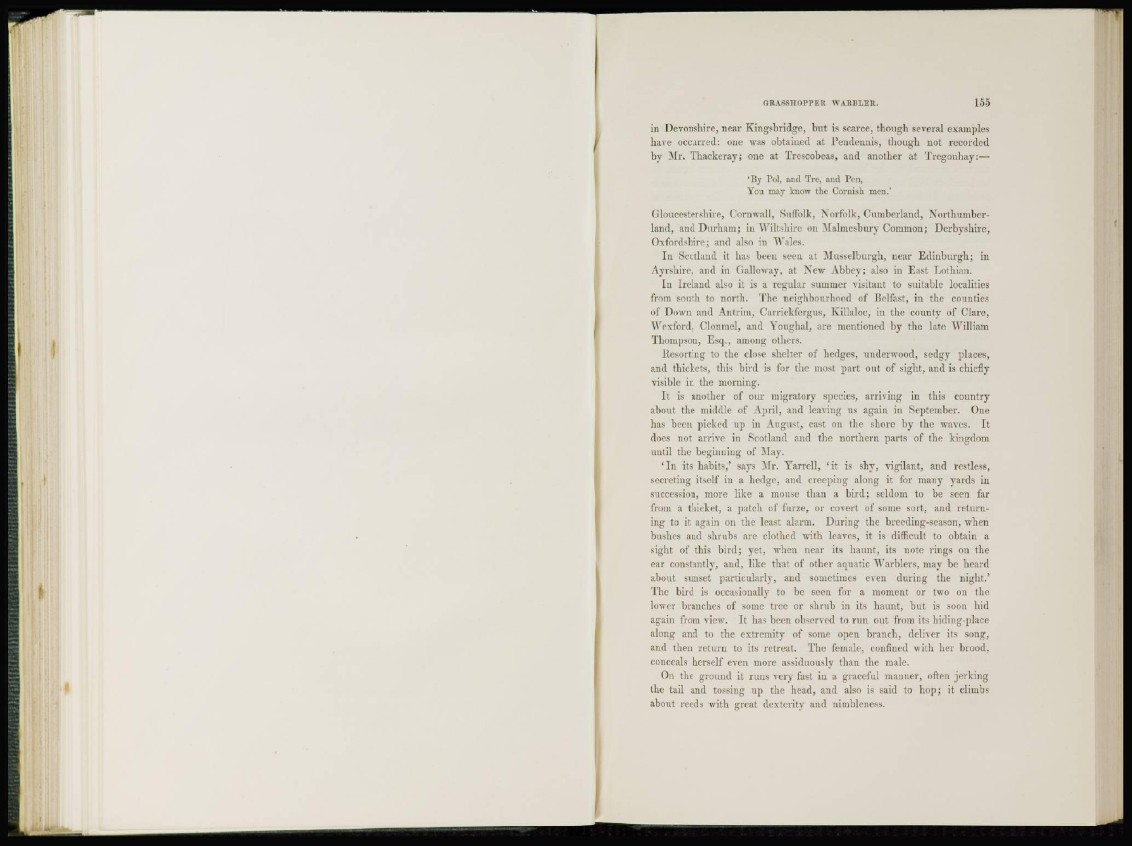
in Devonshire, near Kingsbridge, but is scarce, though several examples
have occurred: one was obtained at Rendeimis, though not recorded
by Mr. Thackeray; one at Trescobeas, and another at Tregonhay:—
'By Pol, and Tre, and Pen,
You may know the Cornish men.'
Gloucestershire, Cornwall, Suffolk, Norfolk, Cumberland, Northumberland,
and Durham; in Wiltshire on Malmesbury Common; Derbyshire,
Oxfordshire; and also in Wales.
I n Scotland it has been seen at Musselburgh, near Edinburgh; in
Ayrshire, and in Galloway, at New Abbey; also in East Lothian.
In Ireland also it is a regular summer visitant to suitable localities
from south to north. The neighbourhood of Belfast, in the counties
of Down and Antrim, Carriekfergus, Killaloc, in the county of Clare,
Wexford, Clonmel, and Youghal, are mentioned by the late William
Thompson, Esq., among others.
Resorting to the close shelter of hedges, underwood, sedgy places,
and thickets, this bird is for the most part out of sight, and is chiefly
visible in the morning.
I t is another of our migratory species, arriving in this country
about the middle of April, and leaving us again in September. One
has been picked up in August, cast on the shore by the waves. It
does not arrive in Scotland and the northern parts of the kingdom
until the beginning of May.
' I n its habits,' says Mr. Yarrcll, ' i t is shy, vigilant, and restless,
secreting itself in a hedge, and creeping along it for many yards in
succession, more like a mouse than a bird; seldom, to be seen far
from a thicket, a patch of furze, or covert of some sort, and returning
to it again on the least alarm. During the breeding-season, when
bushes and shrubs are clothed with leaves, it is difficult to obtain a
sight of this bird; yet, when near its haunt, its note rings on the
ear constantly, and, like that of other aquatic Warblers, may be heard
about sunset particularly, and sometimes even during the night.'
The bird is occasionally to be seen for a moment or two on the
lower branches of some tree or shrub in its haunt, but is soon hid
again from view. It has been observed to run out from its hiding-place
along and to the extremity of some open branch, deliver its song,
and then return to its retreat. The female, confined with her brood,
conceals herself even more assiduously than the male.
On the ground it runs very fast in a graceful manner, often jerking
the tail and tossing up the head, and also is said to hop; it climbs
about reeds with great dexterity and nimbleness.